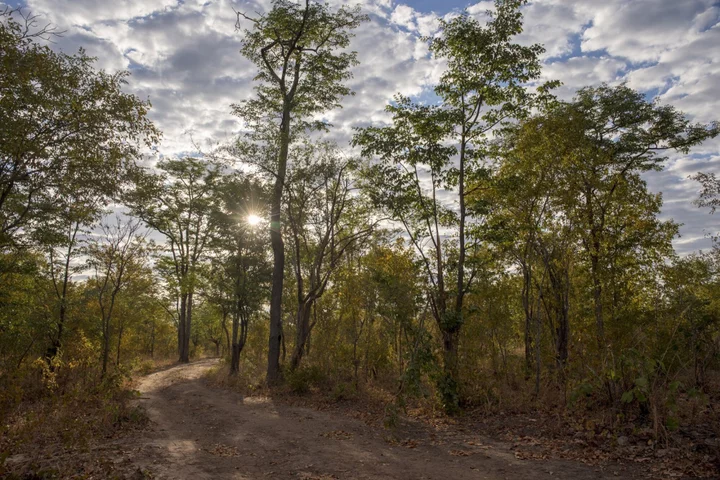When Indonesia agreed last year to clean up its energy system with an estimated $20 billion of help from a coalition of wealthy countries and large financial institutions, world leaders hailed the deal as “extraordinary,” “realistic,” and “historically large.”
Almost 10 months later, as Southeast Asian leaders gather in Jakarta, the hosts have little to show off. A much-anticipated investment blueprint has been postponed. Parties have yet to agree on governance, baseline data or the funding required to curb greenhouse emissions and wean the world’s largest coal exporter off fossil fuels. The most ambitious of the Just Energy Transition Partnerships—the international finance projects designed to cut climate-warming emissions—is faltering.
One especially thorny issue is that Indonesia’s coal-dependency is greater and more complex than all sides initially acknowledged. A 362-page draft document reviewed by Bloomberg spotlights the rapid growth of a fleet of dedicated, “captive” coal-fired plants powering industrial expansion but not connected to the grid. Incomplete data, especially on new and planned facilities, means even the exact scale of the problem is unclear.
“The process started top-down,” said Edo Mahendra, chair of the secretariat tasked with turning the JETP, as the climate package is known, into reality. “Once we do the bottom up, all the devils that lurk in the details come out.”
How these issues are resolved will set a precedent for any future deals, determining to what extent the agreement can create “valuable lessons for the global community [that] can be replicated in other countries to help meet our shared climate goals through concrete collaborative actions,” as Indonesian president Joko Widodo put it in November, when he announced the deal in Bali alongside US President Joe Biden.
Indonesia is the biggest emitter in Southeast Asia by a long shot, thanks to vast coal reserves and a power-station construction boom over the past decade or so. But its regional neighbors and other emerging economies also depend on coal-fired plants that will need to be retired to prevent the worst consequences of global warming. Vietnam is advancing with its own JETP. Senegal struck a deal in June.
In the end, the outcome in Indonesia will also reflect on the credibility of countries that enriched themselves through coal and other fossil fuels for centuries and now cite the need for global emissions cuts. It will test the claims of big private financial institutions that the capital markets can create solutions to the world’s biggest problems.
Bloomberg reporters spoke with more than a dozen people with knowledge of the negotiations, most of whom asked to remain anonymous because the discussions are private and ongoing. They described deep gaps between all sides over even the most basic terms and the scope of the problem they have to fix.
The initial promise of peaking Indonesia’s power sector emissions by 2030 at no more than 290 million tons of carbon dioxide, about 20% below a baseline level for the year, looks out of the question. An alternate scenario laid out in the draft plan would raise the target maximum to 395 MT of CO2, to account for the construction of new captive plants to serve growing industrial power needs.
Read More: Just Energy Transition Partnerships and How They Work: QuickTake
Officials have said they are aiming to have a revised—perhaps final—investment plan before COP28 begins in Dubai at the end of November, taking on public feedback. But to do that, they will need to come to agreement on at least three major, interrelated issues: the money, the emissions target and the mechanics of the coal phaseout, including changes to Indonesian laws and policies that hold back wider green progress.
First, the funds. At around $21.5 billion, according to the latest figures, this is the biggest attempt to blend private and public capital to jump start the energy transition in the developing world, more than twice the size of the original deal struck with South Africa in 2021. The capital is supposed to come from two sources: $11.5 billion mostly in grants and concessional loans from the donors (the Group of Seven economies plus Denmark and Norway), the rest from private-sector investments, marshaled by members of the Glasgow Financial Alliance for Net Zero.
But there may not yet be enough in either bucket. There is just $289 million in grants, with half earmarked for technical assistance—funding for experts, consultants and advisors to model and support the energy transition. Almost all of the rest is loans, at interest rates to be determined later.
For Indonesia, which is responsible for a tiny fraction of historical emissions relative to the donor countries, this adds up to a problem. JETPs are supposed to bring costs for emerging countries more in line with what already wealthy nations would pay, via grant financing or ultra-low-rate loans. They are intended as catalysts, facilitating affordable investment. Otherwise, there’s little financial incentive for Southeast Asia’s biggest economy to risk its own development to clean up the rich world’s mess, as Jakarta sees it, especially when interest rates are rising globally.
To make matters more complicated, there are significant restrictions on how the public money can be used. Around $4.2 billion has already been allocated to specific projects, including two early coal-plant retirements currently underway. The remainder is more flexible—but only roughly a quarter is eligible for shutting down coal-fired power plants, a cornerstone policy that has failed to attract meaningful support in practice.
Read more: Closing Coal Plants Proves a Hard Sell for Big Global Banks
On the private side, people close to the bank partners say investors are waiting to see what their options are. So far, there’s been little appetite for funding phase-outs currently in more advanced negotiations, energy-sector and financing sources say, one a privately owned power plant in Cirebon, the other the state-owned facility in Pelabuhan Ratu. Risks are high, and coal exclusion policies remain in place for many large banks and funds. All fear accusations of greenwashing.
“We welcome the progress that has been made on the Indonesia JETP,” GFANZ said in an email. It declined to comment on ongoing negotiations.
Then there is the question of the emissions target agreed last year. People close to those discussions say negotiators sidestepped the impact of Indonesia’s growing fleet of captive coal-fired power plants, single-purpose engines built to support nickel production and other heavy industry in places the grid doesn’t reach. At best, the issue was dramatically underestimated, which may explain why the original deal included a loophole for new captive coal plants.
This is no mere detail. The captive plants underpin a nickel-processing boom that has placed Indonesia among the major suppliers of minerals critical to the global energy transition. Jokowi, as Indonesia’s president is known, hopes to parlay those reserves into domestic battery and electric-vehicle industries—manufacturing growth, in short, and jobs. The current system is geared to make the most of the country’s resources and fast, but it also means clean-energy ambitions at home and abroad are built on the dirtiest of fossil fuels.
According to the draft, current captive capacity is around 13 gigawatts with another 21.5 in the pipeline, and almost half of that is already under construction. That is higher than previous assumptions—Indonesia’s total coal-power fleet is usually pegged at roughly 40 GW, so captive accounts for about a third—and points to a rate of growth at odds with the need to eliminate coal entirely by mid-century to hit global climate commitments.
Worse, the lack of centralized data casts doubt even on the new figures and makes credible estimates for a clean-up impossible. There are questions around the age, size and function of captive coal plants, which are not part of the numbers published by the state utility and where few parties involved have incentives to be transparent.
All of this is before considering the policies in Indonesia that continue to hamper the transition, including a law governing the sale of state assets that complicates any sale at a loss. Without specific exclusions, executives risk jail, and the past experience of state-owned enterprise bosses offers little ground for comfort. The measure was an anti-corruption tool, designed to prevent directors from cutting sweetheart deals for personal gain, but it’s now also slowing down the reshaping of an economy that relies on coal for growth.
To wind down plants owned by the state utility Perusahaan Listrik Negara, known as PLN, all parties have to agree on the market value of the facilities. Those are likely to be lower than what’s currently on the utility’s books—in 2015, it revalued the assets to help cope with heavy debts—so any kind of sale or refinancing tied to early retirement would register as a loss.
“This is the first constraint,” said President Director Edwin Syahruzad of state-owned infrastructure financing company PT Sarana Multi Infrastruktur, or SMI, set to play a key role in the phaseout. “There’s no way we can have a transaction below the estimated book value because it will bring PLN to the risk of state losses.”
Indonesian officials hope to reassure PLN directors, and the draft proposal lobbies for legislative changes to provide official cover. That’s unlikely to happen soon, given the country is heading into an election year. Meanwhile, processes like the early phaseout of the Pelabuhan Ratu power plant, which PLN values between 12 trillion and 14 trillion rupiah ($790 million to $920 million), remain uncertain.
Of course, there are other pending questions. Will Indonesia negotiate with all of its partners as a group or with each individually? Where will the money come from to update and expand the power grid so it can eventually accommodate renewable energy? What about the government subsidies and other measures that keep coal power cheap, and limit investor interest in solar and wind projects?
People close to the process acknowledge that the issues are more complicated than they anticipated in the months leading up to the initial JETP agreement. They bemoan overly ambitions timelines and insufficient technical preparation.
South Africa’s JETP is also struggling with its own structural, financial and ultimately political issues, which is reassuring to some involved in Indonesia’s planning but ominous to others.
“We really need to make sure we’re finding tools that are a little more of a wholesale approach to this,” said Jake Schmidt, a strategic director at the Natural Resources Defense Council, a US-based advocacy group. “These have to succeed. We have to be able to figure out how to help some countries do an early retirement of their coal fleet.”
Despite the delays and hurdles in Indonesia, no one is yet walking away. The draft investment plan, however imperfect, is progress. Jokowi has made this one of the signature initiatives that will define his final term in office. For the US and its partners, including development banks and some of the financial sector’s biggest private institutions, success will give new credibility to their environmental commitments and burnish their influence in the Global South.
“In an ideal world, of course, there would have been a framework in place, the science would be done, there would be method in the madness,” said Aditya Lolla, the Asia Programme Lead for energy think tank Ember. “But top-down climate action is currently moving the debate, and we take what we can get. Of course, there is a lot of frustration, but there is no going back.”
( GFANZ is co-chaired by former Bank of England governor Mark Carney, who has been named chairman of Bloomberg's board, and by Michael R. Bloomberg, the founder of Bloomberg News parent Bloomberg LP.)
--With assistance from Clara Ferreira Marques, Norman Harsono and Yudith Ho.
Author: Harry Suhartono, Faris Mokhtar and Jennifer A Dlouhy









